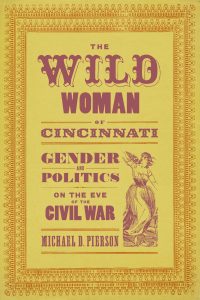Book Review: The Wild Woman of Cincinnati: Gender and Politics On the Eve of the Civil War
The Wild Woman of Cincinnati: Gender and Politics On the Eve of the Civil War. By Michael D. Pierson. Baton Rouge: Louisiana State University Press, 2023. 192 pp. Hardback, $40.00.
Reviewed by Meg Groeling
A book concerning the American Civil War should never be titled The Wild Woman—or should it? Nevertheless, Michael Pierson’s brilliant ability to use a probable hoax show featuring an allegedly feral woman captured “in the West” to present to readers the differences among sections of the country concerning politics in 1856 is nothing short of astounding. This book is a privilege to review.
In 1856, a man—the alleged Captain Northcott—brought a young woman and her attendant to Cincinnati to exhibit as a “feral woman,” available for perusal for 25¢. The show proved popular, and it did not bother folks of that era that it might be a humbug or untrue. Shows like this were expected to be a hoax. Hoax shows were a particular form of entertainment in antebellum America. P. T. Barnum explained that in a hoax, a person displays something that the public would want to see but that they might reasonably think was fake. It then became a battle of wits between the exhibitor and the paying customers to see if the showman could convince his audience that the display was genuine. The showman won if he could keep up the illusion of authenticity long enough for the public to feel it had gotten its money’s worth while trying to figure things out (9-10).
The Wild Woman’s back story was sketchy at best, but Pierson is more concerned with how she was portrayed by the press in all areas—North, South, and in between. He demonstrates with quotes from various newspapers that politically different sections of the country responded differently to the exhibition. Democrats saw the Wild Woman exhibition as unscrupulous, playing on the sexual titillation of a white woman on public display, tied to her bed, unable to speak, and clad in a chemise. Republicans portrayed the same show as the exhibition of a woman as a victim of male cruelty, and if genuine, did no one care to help the poor unfortunate? The author states, “Political parties and regions whose gender ideologies diverge strongly can find themselves at war with one another more easily than when they agree on such matters” (6).
The use of newspapers as primary sources gives this book a feeling of being almost current. Pierson uses the original printing of a review or article, then follows it as it changes in various reprints. He compares how the tone of the reports changes as articles are published further away from Cincinnati. Readers are exposed to many different versions of the Wild Woman and her subsequent trial, which resulted in her show being closed. She was sent to an asylum where she recovered her ability to speak. She claimed that she simply needed to be returned to her family in Texas. At that point, the Wild Woman moved out of the American dialogue.
Contrasting newspaper opinions gives this unusual book (and its topic) importance in Civil War historiography. Pierson compares the position of the Cincinnati Daily Gazette, a Republican newspaper, with other, more Democratic-leaning newspapers. The Republican versions of the Wild Woman saga stress the possibility that her ‘illness” is the result of mistreatment by the men she was unfortunate enough to encounter: she was the innocent victim of male misbehavior. This is to be compared to the Daily Enquirer, the Democratic newspaper in Cincinnati. Although the Enquirer covered her story almost as much as the Gazette, it presented a different image of the situation. It told of her show and subsequent trial. Still, an almost complete silence concerning the eventual fate of the Wild Woman demonstrates, in Pierson’s opinion, an “ideologically driven lack of concern” on the part of a patriarchal vision of society. (82-83).
While Republicans and some Know Nothing editors wrote about the Wild Woman as a wronged victim of male power, Democrats imagined and then presented to the public a Wild Woman who was both complicit in the hoax and utterly passive at the hands of the masterful . . . Williams (Northcott) (83).
The assumed fault line was sectional in nature. Political differences between the North and South were mirrored in the differences in “sex-tional” ideologies. With such a divide in sex and gender expectations, it is easy to see how political agreeability was hard to realize in the United States during the 1850s.
Whether or not readers agree with Pierson, the author’s sourcing is impeccable, and his premise has not been explored before. The Wild Woman of Cincinnati: Gender and Politics on the Eve of the Civil War is challenging and compelling—a worthy read.


If I see one more micro qualitative analysis of an obscure topic seeking relevance under the banner of evaluating the patriarchal society during any time frame, my eyes will bleed, and my hair doth catch fire. ?
Well–there’s that…
One can quibble with micro-history, but it is still a valid lens to examine the social issues of an era. And, of course, we Civil War buffs have no room to complain about being overly specific about minor events. And honestly, I’d rather have this over another thousand page book dealing with the actions of a single regiment or company during a single battle.